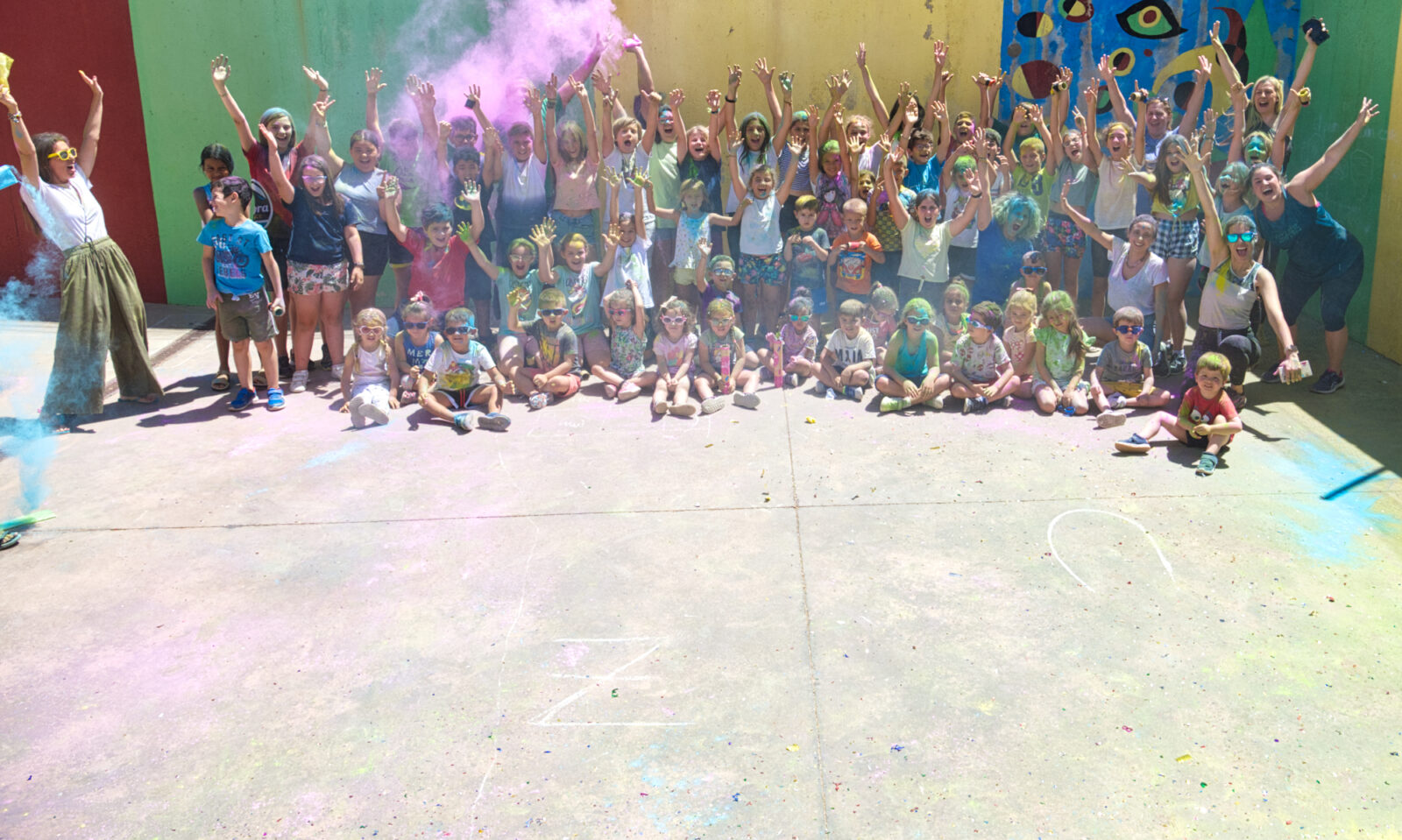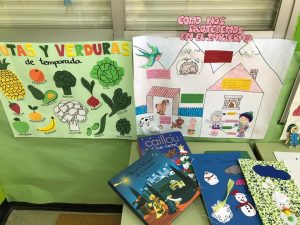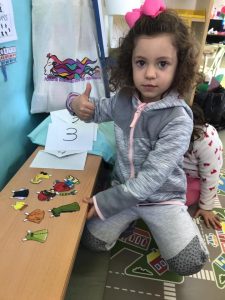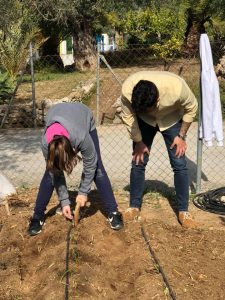🎉 ¡Esta semana en nuestra Biblioteca Escolar os recomendamos nuevos libros! 📚🤓
🎉 This week in our School Library we recommend you new books!! 📚
¿Quién es quién?
¿Quién es Quién? El juego. 🤪
¿Quién es Quién? Es un juego de mesa que nos encanta. Los niños de quinto han jugado creando dos equipos con dos jugadores. Siempre dedicamos unos minutos de clase a juegos que nos entretienen y divierten. ¡En esta ocasión nuestro alumno Álvaro de quinto ha traído el juego de casa! 🙂
El objetivo del juego es adivinar el personaje misterioso del adversario antes de que él adivine el tuyo. Para conseguirlo cada jugador debe realizar, por turnos, diferentes preguntas que solo puedan contestarse con un «sí» o con un «no» del tipo:
«¿Es un chico? Sí, lo es. » – «Is he a boy? Yes, it is. »
«¿Lleva sombrero?» – «Does she have a hat?»
En caso que la respuesta sea afirmativa debemos descartar todos aquellos personajes que no lleven sombrero, por lo que debemos estar muy atentos y concentrados.
Jugar es a ¿Quién es Quién? aporta muchos beneficios ya que favorece el desarrollo de algunas capacidades cognitivas como la memoria, la atención, el lenguaje o la lógica. Pero también permite que el niño aprenda las reglas del juego social y el respeto de los turnos. Además, aprenden de un modo lúdico y divertido a ampliar su léxico descriptivo en cuanto a físico y ropa se refiere, y es muy útil de cara a topics relacionados con la descripción de personas como de animales en cualquier idioma.
Who is who? It is a board game that we love. 🤪 The fifth grade students have played creating two teams with two players. We always dedicate a few minutes of class to games that entertain and have fun. On this occasion, our fifth-year student Álvaro has brought the game!
The objective of the game is to guess the mysterious character of the adversary before he guesses yours. To achieve this, each player must ask, in turns, different questions that can only be answered with a «YES» or a «NO», for example:
«¡Es un chico? Sí, lo es »-« Is he a boy? Yes, it is. »
«¿Lleva un sombrero?» – «Does she have a hat?»
In case the answer is affirmative, we must remove all those characters that do not wear a hat, so we must be very attentive and focused.
This game brings many benefits as it favors the development of some cognitive abilities such as memory, attention, language or logic. But it also allows the child to learn the rules of the social game and respect the turns. In addition, they learn in a fun way to expand their descriptive lexicon in terms of physics and clothing, and it is very useful for topics related to the description of people as animals in any language.
Imágenes Relacionadas:
¡Así aprendemos a construir palabras en Infantil!
Deseamos compartir una bonitas fotos de los niños y niñas de Educación Infantil trabajando y jugando en su aula. 👧🏼👦🏽 Llevamos unos semanas practicando la construcción de nuestros nombres y ordenación de la serie numérica o meses del año a través de letras plastificadas individuales.
La construcción de palabras en niños pequeños no sólo favorece la comprensión de las relaciones entre fonemas y grafemas, sino que les posibilita descubrir con mayor facilidad cómo los sonidos actúan o se “comportan” dentro de las palabras. Es importante considerar el desarrollo de esta capacidad cognitiva como un paso previo imprescindible antes de comenzar la enseñanza formal del código alfabético.
La seño Mayte les propone crear palabras haciendo uso de diferentes consonantes y vocales, pueden trabajar de forma grupal y con diferente grado de dificultad, ya que contamos con el apoyo visual de imágenes y propuestas de construcción de palabras más simples o complejas.
We want to share a nice photos of the students of Infant Education working and playing in their classroom. 👧🏼👦🏽 We have been practicing the construction of our names and arrangement of the numerical series or months of the year through individual plastic letters.
The construction of words in young pupils not only favors the understanding of the relationships between phonemes and graphemes, but also makes it easier for them to discover how sounds act or behave within words. It is important to consider the development of this cognitive capacity as an essential preliminary step before beginning the formal teaching of the alphabetical code.
Mrs. Mayte proposes them to create words using different consonants and vowels, they can work in a group and with a different degree of difficulty, since they have the visual support of images and proposals for the construction of simpler or more complex words.
Imágenes Relacionadas:
Proyecto en Infantil: El Invierno
Exposición y trabajos del proyecto sobre el Invierno. ❄️🥶
El alumnado de Educación Infantil se encuentra inmerso trabajando en su Proyecto: El Invierno. 👧🏼👦🏽
Es significativo que los niños y niñas conozcan detalles importantes sobre la estación del año en la que estamos, que aprendan sobre sus características a través de recursos didácticos relevantes para ellos y que, junto a sus compañer@s y maestra, puedan, además de compartir inquietudes y curiosidades, divertirse jugando.
¿Cómo es el invierno? ❄️
¿A qué podemos jugar en invierno con nuestros amigos? 🎲
¿Qué comidas calentitas podemos tomar en casa? 🍲
¿Cómo prevenimos los catarros? 🤧🤒
¿Cuáles son los animales que se marchan en invierno? 🦅
¿Cómo nos protegemos del invierno? ¿Qué ropa uso en invierno? 🧤🌂🧣
¿Cuáles son los animales que hibernan? 🐻
¿Cuáles son las frutas y verduras que encontramos en esta estación? 🍍
… estas son algunas de las investigaciones realizadas en casa junto a nuestras familias.
¡Muchas gracias por la gran colaboración!
Os mostramos algunas de las propuestas y fotos de la maestra Mayte para los niños de 3, 4 y 5 años.
– Ambientación de la clase, decoramos la puerta y realizamos investigaciones en casa junto a las familias.
– Después de investigar toca exponer y compartir los conocimientos con el grupo-clase. Los alumnos cuentan con apoyos materiales realizados con sus familias en casa. ¡Todos son geniales!
– Partimos de la lectura de poesías fáciles de recordar, adivinanzas o cuentos sencillos como: “Por cuatro esquinitas de nada” del autor Jérôme Ruillier.
– Nos convertimos en pequeños artistas creando muñecos de nieve personalizados con plastilina.
Estas actividades han permitido que creemos nuestro propio rincón del invierno en clase ¡Os animamos a visitarlo si lo deseáis! ¡Un saludo!
Exhibition and project work on Winter. ❄️🥶
Infant Education students are immersed working on their Project: It is Winter! 👧🏼👦🏽
It is significant that pupils know important details about the season of the year we are in, that they learn about their characteristics through teaching resources relevant to them and that, together with their classmates and teacher, they can, in addition to sharing concerns and curiosities, have fun playing.
How is the winter? ❄️
What can we play in winter with our friends? 🎲
What warm meals can we take at home? 🍲
How do we prevent colds? 🤧🤒
What are the animals that leave in winter? 🦅
How do we protect ourselves from winter? What clothes do I wear in winter? 🧣🌂🧤
What are the animals that hibernate? 🐻
What are the fruits and vegetables that we find in this season? 🍍
… these are some of the research carried out at home with our families.
Thank you very much for the great collaboration!
We show you some of the proposals and photos of teacher Mayte for children of 3, 4 and 5 years.
– Atmosphere of the class, we decorate the door and do research at home with families.
– After researching, it is time to expose and share knowledge with the class group. Students have material supports made with their families at home. They are all great!
– We start from the reading of easy-to-remember poems, riddles or simple stories such as: “Por cuatro esquinitas de nada” by the author Jérôme Ruillier.
– We become small artists creating custom snowmen with modeling clay.
These activities have allowed us to create our own Winter corner in class. We encourage you to visit it if you wish! Greetings!
Imágenes Relacionadas:
Taller en Infantil: El zumo de naranja
El pasado viernes los niños de 3, 4 y 5 años realizaron un taller de zumo de naranja para repasar lo aprendido en su Proyecto: El Invierno. 🥶❄️ Han investigado muchísimo y descubierto cosas súper interesantes junto a la maestra Mayte, como por ejemplo que tomar zumo de naranja 🍊 es un estupendo remedio y la mejor medicina para prevenir o curar resfriados en esta época del año.
Hemos contado con la ayuda y colaboración de Rocío, mamá de Juan Antonio, alumno de 4 años, a la que agradecemos que compartiera con nosotros esta bonita experiencia. ¡Eres un solete☀️!
Hemos exprimido todas las naranjas y las hemos bebido juntos después. ¡Qué rico estaba! ¡Compartimos una bonitas fotos!
Last Friday, students of 3, 4 and 5 years held an orange juice workshop to review what they learned in their Project: Winter. 🥶❄️ They have researched a lot and discovered interesting things with teacher Mayte, such as drinking orange juice 🍊 is a great remedy and the best medicine to prevent or cure colds in Winter.
We have had the help and collaboration of Rocío, Juan Antonio’s mother, a 4-year-old student, who we thank for sharing this beautiful experience with us. You are a ☀️ !
We squeezed all oranges and drank them together later. It was delicious! We share a nice photos! Bye!!
Imágenes Relacionadas:
3º Ciclo en el Huerto Escolar
¡Buenas tardes! Nuestro alumnado de tercer ciclo se está animando a participar en el huerto escolar. 👨🏻🌾👩🏽🌾 ¡Y no es para menos! Porque esta herramienta didáctica permite poner en práctica un gran número de competencias y disciplinas al mismo tiempo. A través de diferentes tipos de preguntas, el maestro Fran suscita la curiosidad de sus niños y niñas y promueve su interés por aprender conceptos, habilidades, actitudes y valores que con un método tradicional podrían resultarnos algo menos ameno.
¿Qué materiales debemos utilizar para trabajar en el huerto?, ¿Cómo plantamos las lechugas?, ¿Cómo es el sistema de riego?… Y, por supuesto, todos practican. Permitir probar, experimentar y aprender creando (learning by doing), favoreciendo que el aprendizaje sea significativo.
Nuestra escuela rural tiene la suerte de tener un pequeño terreno alrededor y en esta ocasión hemos contado con la ayuda de nuestro vecino Paco, abuelo de Alejandro, alumno de la etapa de Educación Infantil. ¡Muchísimas gracias por la paciencia, colaboración y recursos! ¡Un saludo!
Good afternoon! Our third cycle students are being encouraged to participate in the school garden. 👨🏻🌾👩🏽🌾 Because this didactic tool allows to implement a large number of skills and disciplines at the same time. Through different types of questions, our teacher Fran arouses the curiosity of his students and promotes the interest to learn concepts, skills, attitudes and values that with a traditional method could be somewhat less enjoyable.
What materials should we use to work in the garden? How do we plant lettuce?… And, of course, everyone practices. Allow to experiment and learn by creating (learning by doing), favoring learning to be meaningful.
Our rural school is fortunate to have a small plot around and on this occasion we have had the help of our neighbor Paco, Alejandro’s grandfather, student of the Infant Education stage. Thank you so much for the patience, collaboration and resources! Greetings!







































































